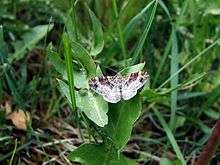Xanthorhoe decoloraria
Xanthorhoe decoloraria, the red carpet, is a moth of the family Geometridae. The species was first described by Eugenius Johann Christoph Esper in 1806 and it is found in northern Europe, to the east across the Palearctic to Siberia and the north of North America; further south (as from Switzerland to Austro-Hungary) it seems to occur chiefly, if not exclusively, in the mountains.
| Red carpet | |
|---|---|
 | |
| Scientific classification | |
| Kingdom: | |
| Phylum: | |
| Class: | |
| Order: | |
| Family: | |
| Genus: | |
| Species: | X. decoloraria |
| Binomial name | |
| Xanthorhoe decoloraria (Esper, 1806) | |
| Synonyms | |
| |
The wingspan is about 32 mm. "Very variable, especially in Iceland, but the forms intergrade so completely that it seems unnecessary to impose names on any but the most extreme aberrations. The ground-colour varies from clear white to smoky grey, sometimes slightly brownish; the median band varies much in width and somewhat in shape; in colour it is usually pale dull reddish, sometimes darker reddish, sometimes grey or even blackish brown. — ab. algidata (Möschl.) Stgr. has the median band almost obsolete, being chiefly indicated by the principal lines which traverse it. It occurs in Iceland, but is said to be a common form, perhaps a local race, in Labrador. On the other hand Möschler says that his algidata cannot be confounded with any known species and the Zeller collection contained under this name a moth more like the Canadian fossaria Tayl. — ab. infuscata ab. nov. [Prout] Forewing much infuscated, dirty grey-brown with slight tinge of yellow, the median band weakly expressed, more reddish; hindwing dark smoke-coloured. Iceland, in my collection. — hethlandica Prout is a race from the Shetland and Orkney Islands with the ground-colour of the forewing strongly yellow ochreous. Similar, though less extreme examples occur occasionally among the other forms in Scotland and Iceland. — labradorensis Pack, has the ground-colour more grey, the band darker, more brown (not red). Labrador. ab. strigata Pack, seems to be merely an extreme development of labradorensis, with the band black. — pauperrimata Chr., which I have not seen, is perhaps somewhat similar to hethlandica. The ground-colour is pale ochreous, the median band uniformly reddish fuscous. Caucasus and the Issyk-Kul and Hi district."[1]
Adults are on wing from mid-June to August.
The larvae feed on Alchemilla species and possibly other low plants.
Subspecies
- Xanthorhoe decoloraria decoloraria
- Xanthorhoe decoloraria hethlandica (Shetland Isles)
References
- Prout, L. B. (1912–16). Geometridae. In A. Seitz (ed.) The Macrolepidoptera of the World. The Palaearctic Geometridae, 4. 479 pp. Alfred Kernen, Stuttgart.